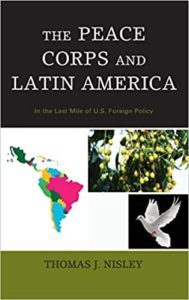Review — THE PEACE CORPS AND LATIN AMERICA by Thomas J. Nisley (Dominican Republic)
 The Peace Corps and Latin America: In the Last Mile of U.S. Foreign Policy
The Peace Corps and Latin America: In the Last Mile of U.S. Foreign Policy
by Thomas J. Nisley (Dominican Republic 1989-91); Ph.D./University of Florida; professor of International Relations and Latin American Studies at Kennesaw State University, Georgia.
Lexington Books, 2018
158 pages
$95.00 (hardcover), $39.99 (paperback), $37.99 (Kindle)
Reviewed by John Chromy (India 1963-65)
•

Thomas Nisley
Reading Dr. Nisley’s book gives the reader a sense of his love and admiration for the Peace Corps, its enormous impact on his own life and somewhat more limited impact on the people in the community in which he served. With that in mind he sets off to examine the Peace Corps’ role in U.S. Foreign Policy, and specifically whether the Peace Corps “makes a difference” in U.S. Foreign Policy.
Like it or not, Dr. Nisley points out that the Peace Corps was conceived as an extension of the U.S. foreign policy, and launched in a period of surging cold war competition. He shares the foundational thinking of Congressman Henry Reuss and Senator Hubert Humphrey, that young Americans living and working in local communities, in a person-to-person approach to development “would create goodwill towards America, promote a better understanding of the people of America and convey the positive aspects of the United States. Even Jack Kennedy’s speech on the stairs of the University of Michigan Union [10/14/1960] contained the theme that America’s role in the world would depend on people being willing to go and spend two years working in huts and villages around the world. Later he said, “the Peace Corps is an opportunity to emphasize a very different view of our American character, instead of the view that the U.S. is a harsh, narrow-minded militaristic, materialistic society”
Nisley points out that in its 60 years the Peace Corps and its supporters have made major efforts to allow the Peace Corps to operate in the interests of the host country people rather than America’s foreign policy. Various Secretaries of State and Peace Corps Directors have taken formal steps to keep the Peace Corps out of the direct foreign policy decisions, while recognizing the successful work of the Peace Corps Volunteers contributes, indirectly in the short term and directly in the long term, to America’s foreign policy goal of building friendships, alliances and trust around the world. This Peace Corps is an indirect, long-term and “soft power” tool of the generally good part of U.S. foreign policy. The author provides several examples where Peace Corps has successfully functioned outside of, and inspite of, the direct foreign policy struggles between the U.S government and the host country. He also provides several examples in which the removal of the Peace Corps from a country was directly related to foreign policy disputes or objectives of the US government — which makes for interesting reading indeed.
The most important, and in my judgment the unique contribution of the Peace Corps, is Dr. Nisley’s efforts to quantify the impact of Peace Corps’ presence in a country . . . which is the second goal of the Peace Corps — to improve the understanding of America and Americans by the host country nationals.
In this endeavor he calls on his extensive academic background and social study theories, specifically a “Contact Hypothesis for the Reduction of Prejudice,”developed by a leading social psychologist. Dr. Nisley utilized his knowledge of statistics and data analysis to analyze 5 years of survey data on perceptions of the US amongst host country people in 4 Latin American countries. In general, the data demonstrates where there has been extensive long-term PC presence with PCVs living and working directly in and among the people, there is measurably more positive perception of the U.S. despite government to government disputes. Reading Nisley’s chapter regarding the topic is heavy going for a non-academic, but it is the only such study of the measurable impact of the Peace Corps this reviewer has ever seen, and it is well worth the reader’s attention.
Overall, Dr. Nisley’s book comes with a good number of anecdotes on decisions made for and about the Peace Corps by Volunteers, staff, U.S. Government officials and host country peoples. Some of that is the “inside baseball” of Peace Corps administration, but most of it is interesting. The reviews of support (or lack thereof) by the ten Presidential administrations from 1961 to 2018 provides some surprising insights, but is mostly discouraging in highlighting the budgetary benign neglect even from Presidents who verbalized/pledged strong support. There are also some interesting observations about the effectiveness of various Peace Corps Directors over the 60 years.
The book ends with Dr. Nisley’s recommendations for re-invigorating the Peace Corps most of which feel a bit stale and carry little invigorating elements in their DNA. All in all, the book is a good read for those seriously interested in the history and future of the Peace Corps.
Author Thomas J. Nisley holds a PhD from the University of Florida, and currently teaches courses of International Relations and Latin American Studies at Kennesaw State University in Georgia.
•
Reviewer John Chromy — PCV India (1963-65); Peace Corps Country Director/Eastern Caribbean (1977-79); Associate Director for Volunteer Recruitment, Selection,Placement, Medical and Payroll Support (PC/Washington-1979-81).
No comments yet.
Add your comment